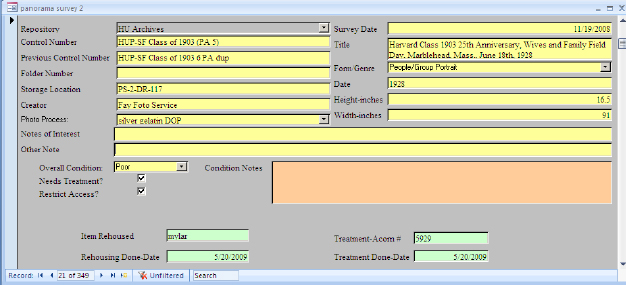
Topics in Photographic Preservation 2011, Volume 14, Article 19 (pp. 122-136)
Presented at the 2011 PMG Winter Meeting in Ottawa, Canada
Panoramic photographs traditionally pose storage and access challenges for libraries and archives. The long format of the panoramas makes them vulnerable to handling damage such as rolling, folding and cracking. The handling problem is worsened by high use, particularly for popular subjects such as class portraits. Since 2007, Harvard Library’s Weissman Preservation Center has worked on an initiative to preserve the panoramas held in multiple repositories throughout the university.
For each repository, the preservation begins with an on-site survey. In addition to condition and format, the survey gathers identifying information which can be used by library staff to generate finding aids or other access tools. Accompanying the survey is on-site conservation work such as minor surface cleaning or repair and rehousing in semi-custom Mylar® sleeves. In some cases, special custom storage options are created.
Photographs in need of extensive repair are flagged and brought to the conservation lab for stabilization treatment. Since many of the panoramas brought into the lab were in moderate to poor condition, a variety of conservation treatments were applied. Some treatments posed more challenges than expected, sometimes due to the panorama format, sometimes due to unstable emulsion. Successful methods of panorama treatment will be given in this paper, including: overall flattening, crease repair, mount stabilization, and releasing emulsion stuck to glass.
The survey, stabilization, and rehousing of Harvard’s panoramas is ongoing, with nearly 1200 having been preserved to date. The project has also helped improve access through cataloging and prioritizing for digitization.
The panoramic format has always been popular for depicting scenic city and landscape views, commemorating special events, and large group portraits. Although the majority of panoramas at Harvard University are 20th century, gelatin silver developed-out prints, a wide variety of photographic processes and presentations can be found in the collections, including mounted albumen prints and cyanotypes.
Panoramic photographs traditionally pose storage and access challenges for libraries and archives. The long format of the panoramas makes them vulnerable to handling damage such as rolling, folding and cracking. The handling problem is worsened by high use, particularly for popular subjects such as class portraits.
Since 2007, Harvard Library’s Weissman Preservation Center (WPC) has worked on an initiative to preserve the panoramas held in multiple repositories throughout the university. The core project team consisted of two photograph conservators, Elena Bulat and Brenda Bernier, and two conservation technicians, Margaret Wessling and Andrea Youngfert. In the later stage of the project, additional assistance was provided by technician Zachary Long and interns Saori Kawasumi and Tatiana Cole.
Goals of the project were:
Harvard University has more than eight million photographs located in over 70 repositories. Because Harvard’s collections are decentralized and a significant portion of the photographs are not cataloged, identifying collections of photographs based on format alone is challenging. The 2002-3 Harvard photograph survey, funded by the Andrew W. Mellon Foundation and carried out by contract photograph conservator Paul Messier and staff of the Weissman Preservation Center, noted the existence of panoramas in a number of repositories. Although the list was not comprehensive, it was a good starting point for the design of the panorama project in 2007. Anecdotally, WPC staff were aware of panoramas in other repositories, some of which had not participated in the earlier survey. A call was then put out for panoramas through several internal Harvard email lists. Collection managers were invited to have their collections included in the project at no cost.
The panoramas at Harvard include well known collections of class pictures at the Harvard University Archives, the Harvard Law School Library, and Countway Library of Medicine. However during the course of the project, numerous panoramas were re-discovered. For example, of interest were a series of panoramas documenting the ravages of a 1938 hurricane to Harvard Forest in Petersham, Massachusetts (Harvard Forest Library), a stadium shot of an early twentieth-century Yale-Harvard football game (Harvard University Archives), and a group portrait of over a thousand individuals who held numbered placards corresponding to a list of names inscribed at the bottom of the photograph (Countway Library of Medicine). To date, nearly 1200 panoramas have been identified at nine repositories.
The purposes of the survey were to assist with both preservation and access. As conservators, we wanted to be able to prioritize for treatment and housing needs. After discussions with collection managers, it became clear that the survey was an opportunity to improve access by collecting data to be used for the accompanying cataloging work and by identifying priorities for digitization.

Figure 1. Survey database included fields for intellectual control and simplified, action-oriented, condition fields.
The data collected for intellectual control included: repository, accession number, storage location, creator’s name, process, genre (eg. landscape, portrait, etc.) size, title, and date of photograph. The condition information was simplified and designed to determine treatment and housing priorities and track when completed. If treatment was done in the lab, a tracking number specific to the lab’s treatment documentation system (ACORN) was noted in the survey. To collect all findings a database was designed in-house using Microsoft Access software. (See figure 1.) A new copy of the database was used for each repository so that each collection manager could then use the data as necessary in creating finding aids or catalog records.
Accompanying the survey was on-site conservation work for minor problems such as slight surface dirt, small tears and isolated areas of flaking emulsion on the edges of the photographs. Given the large number of panoramas to be treated and the challenge of transporting them across campus, it was more expedient to perform the minor treatment work on-site. Surface dirt was reduced with soft brushes and vinyl erasers. Small tears were mended with wheat starch paste or methyl cellulose and Japanese tissue, although in some cases, remoistenable tissue was used. Edge flaking was consolidated with methyl cellulose due to the challenge of keeping a gelatin solution warm while working on-site.
Once stabilized, the panoramas were rehoused in semi-custom Mylar® locking sleeves (Wagner, 1991). The Mylar® is manufactured into essentially a 225 foot trifold locking sleeve. The custom rolls are made to order in two different widths: 10-1/2” and 17-1/4”. To use, the sleeve is simply rolled out and cut to the length of each panorama. (See figures 2 & 3.)
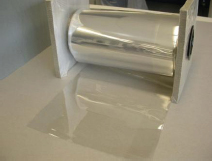
Figure 2. Roll of semi-custom Mylar® panorama sleeves.
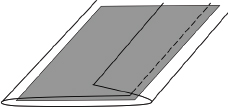
Figure 3. Panorama sleeve functions as a trifold locking sleeve.
Photographs in need of extensive repair were brought to the conservation lab for stabilization treatment.
During the project we identified several problems common to panoramas:
The challenges and treatment strategies for these different types of deterioration will be detailed below.
Rolled photographs. Many panoramas came to the WPC conservation lab tightly rolled. The rolled photographs were flattened with use of a humidification chamber, followed by flattening under pressure. We attached an ultrasonic humidifier to the dome of a suction table to use as the chamber. (See figure 4.) The suction mechanism was not used. The photographs were placed on Hollytex® over a plastic grid to encourage air flow under the photographs. Some photographs required only 1.5-2 hours inside of the chamber and it was enough to relax the paper and the emulsion. (See figure 5.) The ease of humidification varied depending on the size of the panorama, the diameter of the roll, and the thickness and condition of the paper support. In other cases, humidity was passively introduced by using dampened capillary matting under the plastic grid instead of ultrasonic humidification.
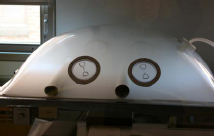
Figure 4. Dome of suction table used as humidity chamber.
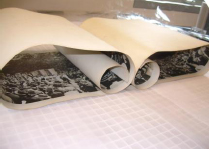
Figure 5. Rolled panorama during humidification.
The humidified photographs were dried in packs consisting of three thin, smooth blotters, Hollytex®, panorama, Hollytex®, three more blotters, Plexiglas® sheet, and weights. Often, multiple panoramas were stacked in this way to form a single pack, under the weighted Plexi. During the drying process, the blotters were changed once within the first few hours, then again the next day. The drying packs were left undisturbed for at least a week, and longer when possible.
Lined photographs. A number of panoramas had linen backings that were cracked from being tightly rolled and stored in an environment with fluctuating humidity levels. The degraded textile aged differently from the paper support of the photographs. In our lab, we try to avoid using overall wet treatments when possible. However, thorough testing indicated that some broken linen backings were best removed through overall immersion. (See figures 6 & 7.)
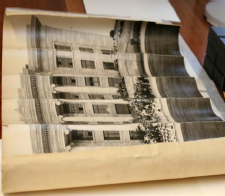
Figure 6. Linen backed photograph before treatment, from Countway Library of Medicine.
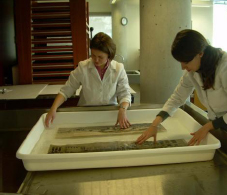
Figure 7. Technicians Margaret Wessling and Andrea Youngfert immersing linen backed panoramas.
After removing the linen backing, some photographs were lined with Japanese paper. Other photographs were simply mended, dried to flatten in a drying pack as described above, but without added weights, and placed into a locking Mylar® sleeve with an additional rigid support, usually 2-ply archival mat board.
Broken mounts. A bridging technique adapted from the field of book conservation was used to stabilize broken mounts. This was used when it was not possible or desirable to remove the photograph’s backing. The idea is to insert a flexible yet strong repair paper between the middle layers of the mount in order to attach both parts together. (See figures 8 & 9.) The bridging repair paper could be made with Japanese paper and Hollytex® or just Japanese papers. Sometimes Korean papers were used instead of Japanese papers for added strength (Yum, 2005). The adhesive was a strong wheat starch paste cooked using the so-called “brain” method. With this method, one part Aytex P® wheat starch paste is cooked with two parts deionized water until the mixture obtains a thick, rubbery consistency. The name of the method is derived from the brain-like appearance of the cooked adhesive. Paste cooked in this way is very strong and can be thinned as necessary for various applications.
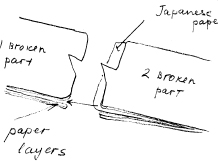
Figure 8. Bulat’s representation of repair technique.
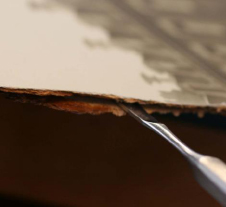
Figure 9. Separating layers of mount board to accommodate repair tissue.
Another technique was used to mend cut photographs. Several unmounted panoramas had been intentionally cut at some point in the past, probably to aid in storing. One particularly long panorama (146 cm) was cut in four pieces. Since the cut edges did not have the natural shelf of a torn photograph, mending was difficult. Japanese paper fibers were used with the strong wheat starch paste described above. The fibers were applied repeatedly from the back in the space between the perfectly aligned fragments and then applied from the front to stitch the two sections together, followed by standard mending on the back with Japanese paper. This mending technique is quite strong and could support the weight of such a long panorama. As added security, a rigid support was added to the Mylar® sleeve for housing.
Gelatin Emulsion Cracking. Many gelatin silver photographs have problems with cracked or flaking emulsion on the edges. In those cases, we usually consolidate where necessary with 2% gelatin, with or without added ethanol. However, we came across a few panoramas with cracked gelatin emulsion over the entire surface. (See figure 10.) In these cases local treatment under the binocular microscope was not an option. After experimenting on test prints and discussing the issue with the curator, we decided to consolidate with an overall application of gelatin and heat.

Figure 10. Detail of panorama with extensive emulsion cracking.
A gelatin solution of 2-4% with added ethanol was applied in several coats using a hake brush. In order to minimize dust settling on the surface of the wet coating, the photograph was placed under the dome of the humidification chamber, allowing us to work through the access portals of the dome. (See figure 11.) Pieces of Plexiglas® were used on the edges of the photograph to minimize cockling. When the gelatin was completely dry, the print was placed in a low temperature dry mount press, usually at 160°F or 180°F for two minutes. This reduced cockling and flattened the cracks. The next day the treatment could be repeated if necessary.
This treatment was used only for those photographs that already had a significantly altered surface because of severe cracking. Some, but not all, photographs treated in this manner had a slight yellowing of the highlights after treatment. Spectrophotometer readings showed a less than humanly perceptible visual change.
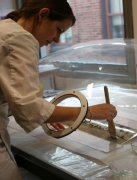
Figure 11. Coating photograph through access portals of humidification dome.
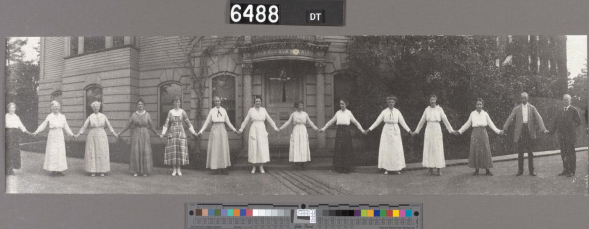
Figure 12. 1917 panorama of Observatory staff, who were known as “computers” for their mathematical acumen. The untitled photograph from the Harvard College Observatory is colloquially referred to as the “Paper Dolls” panorama.
One example of severe emulsion cracking and flaking was found on a 1917 panorama of staff from the Harvard College Observatory. (See figure 12.) The cracking was so severe that it even penetrated through the baryta layer and covered the entire surface of the photograph. (See figure 13). The reason for severe emulsion cracking may not always be obvious but examination of this photograph provided clues about the print’s past history. The back of the print had remnants of dry mount tissue mostly in the center of the print and rubber cement adhesive on the edges towards the center. The yellowed dry mount tissue adhesive, which was probably shellac based, failed, resulting in the complete separation of the photograph from its mount and uneven localized separation of the tissue from the photograph.
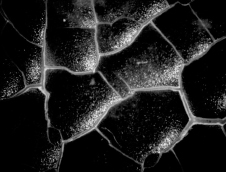
Figure 13. Close-up detail of cracking showing penetration of baryta layer.
The severe cracking through the baryta layer might be the result of excessive heating which could have occurred if someone put the panorama in the dry mount press a second time with the intention of re-activating the tissue. Finally, the photograph was readhered to the mount with rubber cement, which eventually also failed.
The severity of the cracking made it impossible to handle the panorama without creating more losses. The emulsion was temporarily stabilized by applying a 1% gelatin solution with an ultrasonic mister. After several applications over all, the photograph was stable enough to be able to carefully flip it over and mechanically remove the remnants of the dry mount tissue on the back. The dry mount tissue peeled off easily, with no solvents required. The bulk of the rubber cement adhesive was mechanically reduced. A 3% gelatin solution was applied by very soft large brush directly to the surface of the photograph to consolidate the emulsion. Unlike the other treatments described above, the dry mount press was not used because the surface was believed to be too fragile. This treatment improved the gelatin stability greatly even though the cracks are still visible. A special housing was made to accommodate the photograph.
Water-Sensitive Gelatin Emulsions. Not only were some panoramas too fragile for wet treatments, they were too sensitive for even a drop of direct humidification.
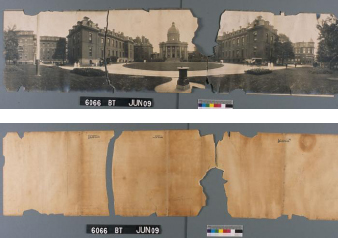
Figures 14 & 15. Before treatment recto and verso of panorama from Countway Library of Medicine.
A photograph from Countway Library at the Harvard Medical School was in direct contact with a wooden backing for many years. (See figures 14 & 15.) It came to the lab in 3 separate fragments with many losses. There are 4 copies of this same image in the collection; however they were all damaged in different ways so all four were treated. For this particular copy, the initial proposal was to wash the fragments in water in order to stabilize its paper support. The photograph was first surface cleaned using only a soot sponge. After surface cleaning, one fragment was prepared for washing by applying direct humidification through a pack of wet blotter and Hollytex® and also by spraying a fine mist of deionized water on both the front and back. It was at this time before emersion, that a drastic change in the emulsion was seen along the fragment’s edge and vertically through the middle of the fragment. (See figure 16.) The vertical emulsion deterioration correlates to the most acidic staining seen on the back of the fragment. After seeing this change, the treatment was immediately halted for further research and discussion with the curator.
After a series of tests, 8% Klucel G® adhesive in ethanol was selected as a non-aqueous adhesive for the remainder of the treatment. It was used to reattach the fragments and fill the losses on the photograph as well as to line the photograph in sections with Japanese paper. Japanese paper RK-20® was used for bridging the losses on the verso and Dove’s Grey® western paper was used for filling the losses on the front. For all the panoramas, we did not attempt to recreate lost image when filling losses but only tried to use fill paper that was sympathetic in tone. Mended tears and creases were inpainted with reversible techniques.
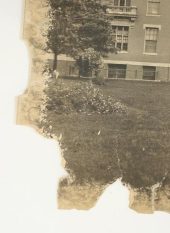
Figure 16. During treatment detail showing emulsion damage in area of extreme paper oxidation.
After treatment the photograph was housed in a Mylar® sleeve with a support board of corrugated archival board. Presently the photograph is physically stable, but since the paper support and gelatin emulsion are significantly degraded, it should be monitored over time for its condition.
Anecdotally, this kind of extreme reaction to humidification has been observed by a few conservators over the years, but the phenomenon has never been documented in the conservation literature. In this collection, there were many panoramas made by the same photographer, from the same timeframe (ca. 1900). We had hoped that similar photographs would react to treatment in the same way. However, this collection proved that this assumption was not always correct and reinforced the notion that each photograph should be thoroughly tested prior to treatment.
Emulsion Stuck to Glass. When gelatin silver prints are in direct contact with the glazing of frames, it is not uncommon for the emulsion to swell with humidity or moisture and become blocked, or stuck, to the glass. The probability of successfully removing the glass varies with the area of adhesion, strength of adhesion, and overall condition of the emulsion. Often the emulsion is compromised by accompanying water damage, such as mold damage or flaking. For panoramas stuck to glass, we have found that the probably of successful removal is not high but worth testing. Techniques we have tried but found unsuccessful include: mechanical removal; heat applied with warm spatula or scalpel; heat applied from the verso with a heated pad; cold applied with ice packs; direct humidification from the verso with a damp brush; and direct humidification applied with a damp brush to the recto where air channels permitted access. Complete immersion, while potentially successful, was not considered for the panoramas due to the challenges of the long format and in some cases, the fact that the glass was cracked. The most successful technique was to use a portable clothes steamer on the blocked areas where there were air channels between the emulsion and the glass. The combination of heat and humidity seemed to be the key. The steamer was used with the photograph propped, glass side up, for maximum viewing during treatment.
A collection from Houghton Library included 226 composite panoramas of Havana which were folded into eight envelopes with identifying information, and one paper document containing information about the collection. (See figure 17.) The circa 1890’s photographs and the envelopes were extremely fragile, with edge flaking and severely oxidized paper support.
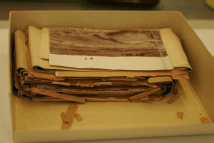
Figure 17. 226 folded panoramas from Houghton Library, before treatment.
After all the photographs were stabilized and organized by groups, a special custom housing was made. The housing system incorporated the semi-custom Mylar® locking sleeves previously described for standard panorama housing. In order to keep the groups of panoramas together, three locking pockets were needed for each sleeve. To do this, two additional seams running the length of the sleeve were made using the ultrasonic welder. The top layer of Mylar® was then sliced just above the seam to create a way to open each pocket. Finally, an additional strip of Mylar® was welded along the seam to create the locking mechanism on each pocket. (See figure 18.)
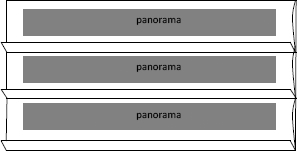
Figure 18. Customized, three-pocket, locking sleeve
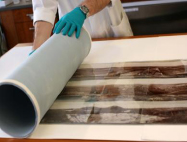
Figure 19. First set of three panoramas rolled onto tube.
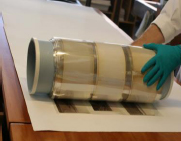
Figure. 20. Multiple sets of three rolled onto tube.
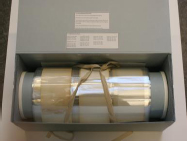
Figure 21. Rolled panoramas in custom box.
The stack of sleeved panoramas was then rolled onto a tube and placed in a custom box. In this way, all 226 photographs and supporting documents were accommodated in this one box, which was remarkably compact and lightweight. (See figures 19-21.)
Available storage for panoramas varied by repository so we worked with the curators to develop a storage strategy prior to surveying and rehousing their collections. While many panoramas could be stored in standard flat files, approximately 25% of the photographs were too long and required alternative storage. Some were rolled and boxed as described above, although we preferred to devise solutions that enabled the panoramas to be kept flat.
For photographs that remained stuck to glass, or for panoramas too long for cabinet storage, custom housing was made with corrugated archival board. (See figure 22.) Because the housings for panoramas were quite long, the bottom support was constructed with two boards adhered at cross-corrugation for added strength. When possible, the front and back cover was made from a continuous piece of archival board to eliminate the need to attach the two sections with either linen tape or Tyvek® adhered with poly vinyl acetate (PVA) adhesive. The interior design was much like a sink mat but with side walls made of corrugated archival board wrapped in archival paper. The front could be flipped down for easier access to the photograph. Cotton twill tape was threaded through small slits in the cover and secured with PVA. (See figure 23.) Simple portfolios were made by omitting the sink feature. The portfolios were made to provide library staff with a way to transport the panoramas safely from storage to the reading room.

Figure 22. Custom housing for panorama stuck to glass.
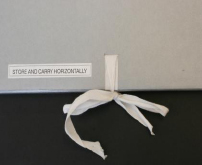
Figure 23. Detail of custom housing showing tying mechanism and use of label.
For the Harvard University Archives, we assisted with the organization and storage of 503 panoramas that were surveyed, treated, and rehoused in Mylar® sleeves. Most were arranged in folders in flat files but approximately 130 panoramas were too long for the flat files. We designed and constructed six boxes made of two-ply archival corrugated board. (See figure 24.) The interior of the boxes had additional walls made of folded corrugated board to keep the whole structure rigid. The boxes accommodated 20 to 25 panoramas in their Mylar® sleeves. Because the photographs were arranged by accession number, there were both sleeves with the wider and narrower widths interspersed in each box. In order to keep the smaller width sleeves from shifting in the box, each had an added section of a larger Mylar® sleeve to act as a spacer. (See figure 25.) The spacer had the added benefit of giving a place for the title and other identifying information. The corrugated board structure was surprisingly light and strong but still required two people for handling because of its long length.
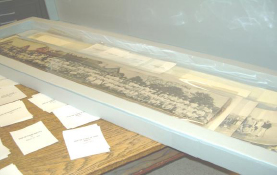
Figure 24. Custom storage box for oversized panoramas.
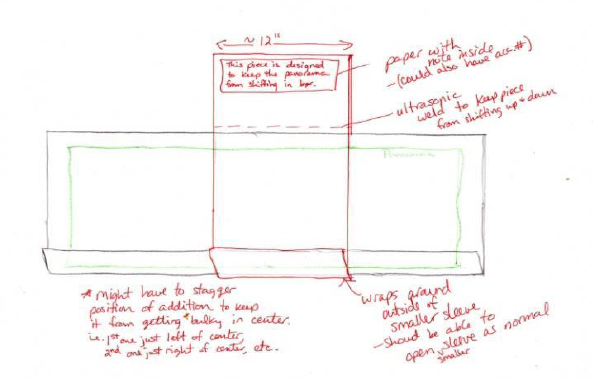
Figure 25. Bernier’s original conceptual drawing of Mylar® spacers.
The final component of the project was digital imaging for selected images. The curators decided which images they wanted to make digitally available and worked with Harvard Library’s Imaging Services. Panoramas stuck to glass were good candidates for imaging because of the difficulty of access. The images were made available through VIA, Harvard’s online catalogue. Digitization allows enhanced viewing as the researcher can zoom in on small details that were previously overlooked. This feature is particularly useful for genealogists and historians examining class pictures and other group portraits.
Through the Weissman Preservation Center’s initiative to preserve panoramas at Harvard University, nearly 1200 panoramas from 9 repositories have been surveyed and stabilized to date, including: Harvard University Archives, Houghton Library, Harvard Forest Library, Harvard Law School Library, Countway Library of Medicine, Harvard Ukrainian Research Institute, Schlesinger Library for the History of Women in America, Harvard-Yenching Library, and the Harvard College Observatory. It has been a substantial project, with over 1400 hours worked by seven individuals over the course of four years.
The initiative enabled the Photograph Preservation Program to develop workflows that could be efficiently applied to multiple collections, and this allowed us to provide service to multiple repositories, some of which had been traditionally underserved. By focusing attention on a single format, staff gained a much deeper understanding of the materials and techniques used to create panoramas, the historical context of the collections, and a range of techniques and materials for successful panorama treatments. The preservation benefits of the project include the stabilization of hundreds of fragile photographs as well as safer and easier storage and access for library staff. The panorama initiative provided immense improvements to access by identifying panorama collections throughout Harvard, enhancing access to collections traditionally difficult to serve to patrons, discovering previously rolled images, streamlining the cataloging process for collection managers, and enabling prioritization for digitization.
ELENA BULAT
Photograph Conservator
Weissman Preservation Center
Harvard Library
BRENDA BERNIER
Paul M. & Harriet L. Weissman Senior Photograph Conservator
Weissman Preservation Center
Harvard Library
We would like to thank our colleagues from the Weissman Preservation Center, particularly Melissa Banta and Robert Burton of the Photograph Preservation Program, and our project partners throughout Harvard’s libraries and archives. We are also appreciative of generous support provided by the Andrew W. Mellon Foundation and Paul and Harriet Weissman.
Reinhold, Nancy. An investigation of Commercially Available Dry Mount Tissues, Topics in Photograph Preservation, volume 4, 14-30, 1991
Wagner, Sarah S. Some Recent Photographic Preservation Activities at the Library of Congress, Topics in Photographic Preservation, volume 4, 136-150, 1991
Watkins, Stephanie. Origins and Development of Dry Mounting, The Book and Paper Group Annual, American Institute for Conservation, volume 12, 1993
Yum, Hyejung. Traditional Korean Papermaking, Scientific Research on The Pictorial Arts of Asia, proceedings of the second Forbes Symposium at the Freer Gallery of Art, 75-80, 2005.
Atlantic Protective Pouches
http://www.atlanticprotectivepouches.com/
Papers presented in Topics in Photographic Preservation, Volume Fourteen have not undergone a formal process of peer review.